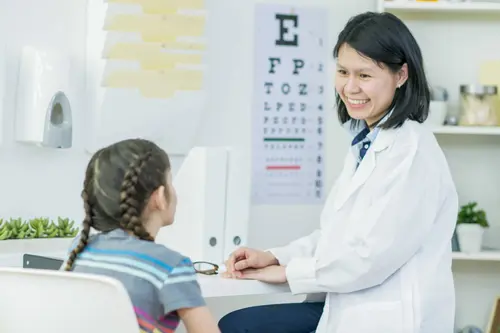
These specialists deal with the eyes, from the anatomy, physiology and even their related diseases. Ophthalmologists diagnose and treat patients with eye problems and diseases and might also perform eye surgeries.
Methods for Diagnosing Eye Conditions: Ophthamology Screenings
From birth and childhood to old age, screening tests should be regularly scheduled as while some eye conditions may be detected during childhood, others may appear later on.
Through consistent maintenance of eye health, Gleneagles Hospitals' Ophthalmology specialists strive to ensure early diagnosis and treatment options for any current or even potential eye disorders and diseases.
Visual Acuity Testing
Cornoreal Topography
Tonometry
Refraction
Dilated Pupillary Exam
Eye Conditions and Symptoms
Strabismus
Age-Related Macular Degeneration (AMD)
Described as a central loss of vision, AMD typically affects adults over the ages of 50 and is attributed to damage to a small area central of the retina called the macula.
The most apparent symptom is blurred central vision as well as the lack of ability to tackle tasks that require "straight ahead" vision.
Amblyopia (lazy eye)
Usually developing in childhood due to improper development of vision from uncorrected squinting or refractive errors, this condition reflects poor vision without the presence of eye disease.
Only one eye is usually affected, but it is possible for Amblyopia to be present in both eyes.
Myopia
More commonly known as short-sightedness, the most common symptom is the inability to see objects that are far away and tends to develop in early childhood.
Typically corrected with glasses, other common symptoms include blurry vision when focusing on distant objects or when reading.
Glaucoma
As a disease that damages the optic nerve, Glaucoma is usually present in older individuals causing loss of sight and if untreated, permanent blindness.
Because it has no visible symptoms in early stages, this can lead to gradual loss of peripheral (side) vision, tunnel vision, and finally if not treated, permanent vision loss.
Hyperopia
Farsightedness is a condition that makes it difficult for the patient to focus on objects closer to their eyes. This is due to the eyeball being physically too short to effectively refract light and is usually solved with prescription lenses.
Symptoms of farsightedness can also include overall blurred vision and sore eyes from reading text and headaches.
Cataract
Indicated via a cloudiness on the lens of the eye, this condition usually develops in older individuals but can occur as a result from injury or trauma, prolonged eye inflammation as well as steroid treatment. Certain infants can also be born with cataracts.
The most common symptom exhibited by cataracts is blurry vision however other symptoms can include fading colours, light sensitivity, glare and double vision.
Presbiopia
Deemed as the loss of one's auto-focus function in the eye to nearer objects, this is caused by ligaments of the eye lens hardening naturally over time. This condition is often confused with hyperopia.
Other common symptoms include visual fatigue and the inability to read small texts. Presbyopia can also occur with other refractive errors.
Gleneagles Hospitals Opthalmological Facilities
We at Gleneagles Hospitals are dedicated to helping you and your loved ones see it through the tiresome and elaborate process of eye-related diagnosis, treatment and care.
Quality medical care aside, we provide each patient access to nothing but the best in modern innovative medical technology. Our team of health professionals create personalised treatment plans to best suit each different individual and their lifestyles, prioritising the best possible outcomes to minimise any possible side effects during your recovery process.
To further help you maintain good eye health and preserve your vision for as long as possible, it is vital that your overall health is taken care of. As our sense of sight is an essential and valuable part of life and our well-being, our expert, compassionate and committed team of dedicated eye professionals are ready to help you every step of the way.
If you or maybe your loved ones are having any concerns regarding changes or disturbances in sight, please do not hesitate to set up an appointment and our team will take care of the rest.


